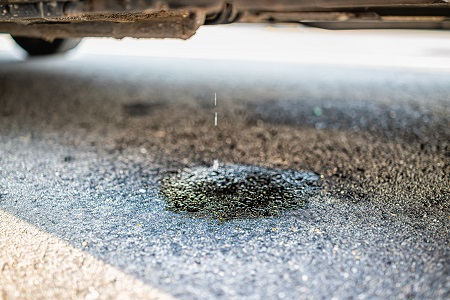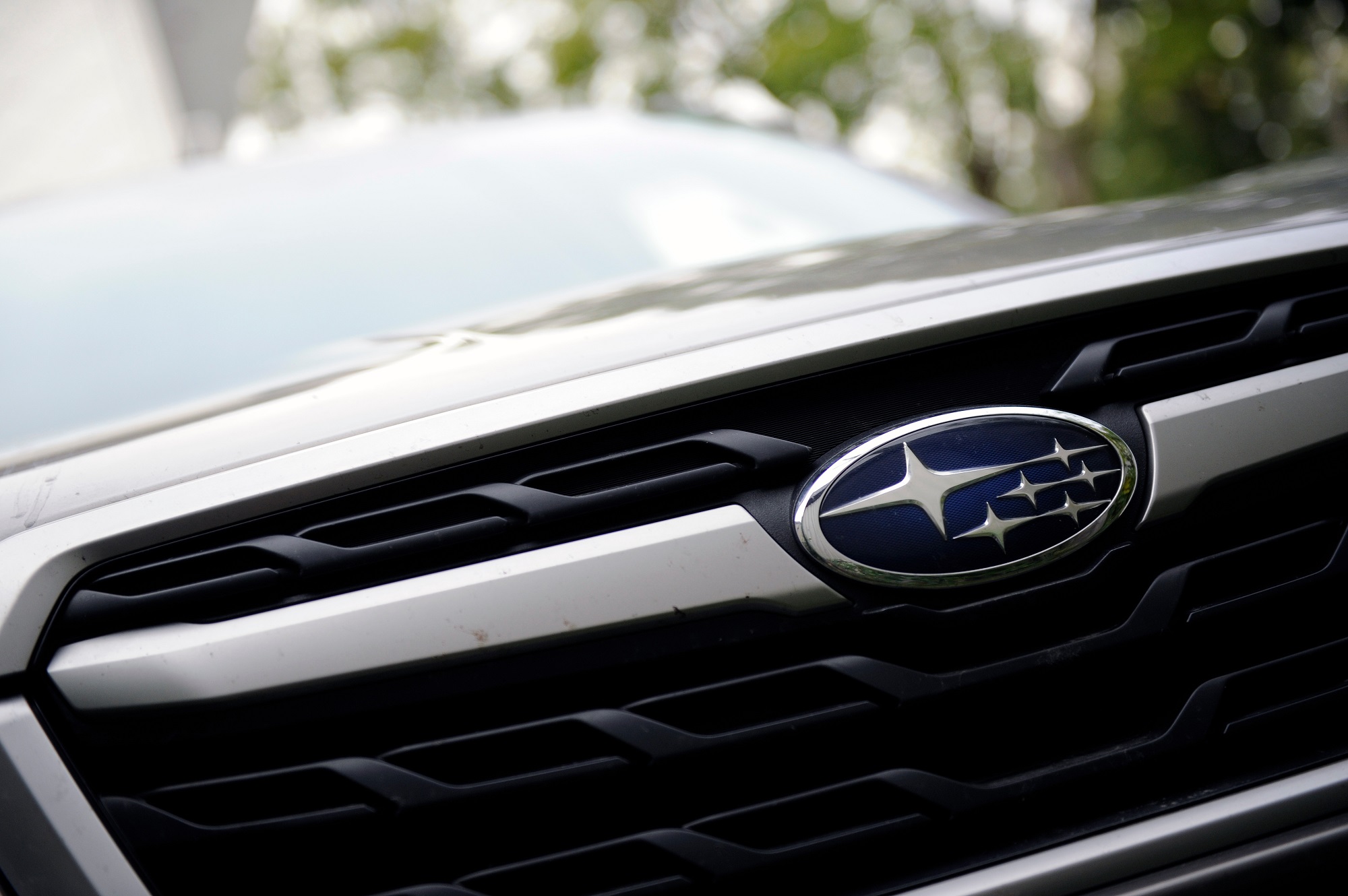You’ve spotted a puddle under your car, and you’re worried. Don’t panic! Recognizing and fixing your car’s fluid leaks isn’t as tough as you’d think.
This guide will help you identify whether it’s oil, coolant, or even brake fluid that’s leaking and walk you through the steps to fix it.
Remember, safety always comes first, so let’s get your car back in top shape without risking any harm.
Ready to roll up your sleeves? Let’s get started!
Go to Trafton’s Foreign Auto for any leak issues you are experiencing. We work on many different car makes such as Audi, VW, Porsche, and Subaru services.
Signs and Symptoms of a Fluid Leak

Keep an eye out for puddles under your car, as they’re a common sign of a fluid leak. The color and consistency of the fluid can help you identify the type of leak: oil is usually light brown to dark and is thicker than water. Coolant is often green and slippery with the consistency of water, while brake fluid is clear but very slippery and thinner than oil. Transmission fluid feels similar to oil but usually red and has a pungent smell. If you spot any of these, it’s best to get your vehicle to a professional ASAP to prevent further damage.
A leak can cause your car’s cooling systems to overheat, corrode, or even fail, posing a risk to your safety. Regular checks and maintenance are crucial for catching and fixing leaks early, so don’t neglect your car’s health. It’s not just about the car’s performance; it’s about your safety, too.
How to Identify an Oil Leak
You’re not always going to see a pool of oil under your car if there’s a leak. The first place to check is your oil level. If it’s decreasing rapidly, you might have a leak. To confirm, inspect the engine bay. Look for oil on the lower engine cover or on a wet oil pan, a telltale sign of a leak.
Next, check your parking spot. No visible pool doesn’t necessarily mean no leak. Look for dark stains or spots. Sometimes, this may not be apparent if you have a lower engine shield that is catching the oil.
Commonly, engine leaks can cause oil to drip onto hot components, such as exhaust components, which will cause a burning smell and sometimes smoke. This smell is common in VW and Audi 1.8 and 2.0 engines as well as Porsche Macan and Porsche Cayenne cars.
Now, safety first! Don’t touch hot engine parts or oil; it can lead to burns. It’s best to take your vehicle to a professional. An oil leak could be a symptom of a serious issue that needs immediate attention.
Steps to Fix an Oil Leak
Both identifying and fixing an oil leak can be tricky, but with the right tools and experience, you’ll have it sorted out.
First, ensure you’re wearing appropriate safety gear – gloves and goggles are a must.
Locate the leak by inspecting the oil pan, filter, and plug for any damage. If you find the source, you’ll need to drain the remaining oil and replace the damaged part.
This could be as simple as tightening a loose filter or replacing a worn gasket. Be sure to properly dispose of any drained oil, following local regulations.
Once you’ve replaced the part, refill your oil tank with the correct grade. Start your engine, let it run for a few minutes, then check for any further leaks.
Detecting Coolant Leaks
Next, you’re tackling the task of detecting coolant leaks in your vehicle, a common problem that can lead to overheating. Start by inspecting the radiator and hoses for visible leakage. The coolant on VW, Audi, and Porsche is typically pink, and it’s slippery to the touch and will often have a musty smell when released as steam. Don’t forget to check the ground beneath your car for any puddles.
If you can’t find visible signs, you’ll need a pressure tester. Attach it to the coolant reservoir when the vehicle is at operating temperature, but be careful not to burn yourself when unscrewing the cap to your pressurized reservoir. Pump your pressure tester to approximately 16lb depending on the vehicle. If the pressure drops, there’s a leak. If it is a very small leak, it may take several hours for the pressure to drop.
Always remember, safety first! Never open the radiator cap when the engine is hot, and use protective goggles. And, if you’re not comfortable doing this, it’s best to take your car to a professional mechanic.
Effective Ways to Repair Coolant Leaks
Where should you begin when you’re looking to effectively repair a coolant leak in your vehicle? First, ensure you’re wearing the right safety gear. This includes gloves and safety glasses to protect your hands and eyes from the coolant.
Here’s a step-by-step guide to help you:
- Identify the source of the leak. Look for pink fluid (assuming it has the correct color of coolant) underneath your car.
- Replace or repair the faulty part. This could be the radiator, water pump, hose, cylinder head gasket, or another component.
- Refill the system with new, clean coolant.
- Purge air from cooling system and re-check coolant level. Use recommended vacuum fill tool for purging cooling system.
Remember to dispose of the old coolant properly. It’s toxic and hazardous to both humans and animals. Proper safety measures should always be your top priority.
Other Common Car Fluid Leaks: Transmission, Brake, and Power Steering Fluids
Your car’s transmission, brake, and power steering fluids are also prone to leaks, which we’re going to delve into next. You’ll often notice these leaks as distinct puddles under your vehicle.
Transmission fluid is typically red or brown, while brake fluid is clear to yellow and slippery. Power steering fluid resembles transmission fluid but can also be a light yellow. Be careful when touching these fluids as they can harm your skin and eyes.
To fix these leaks, first identify the source. You can do this by inspecting the hoses and connections related to each system. If you find a loose connection, tighten it. If there’s a damaged hose, replace it. Always ensure your safety by wearing gloves and using the right tools.
Always make sure when adding or replacing brake fluid and steering fluid to purge the air from the system or you may have bigger issues.
If the leak persists, consult an experienced mechanic. Regular checks can prevent these leaks, ensuring your car’s longevity.
Trafton’s Foreign Auto Can Help You with any Fluid Leaks You Have or If You Need VW, Audi, or Subaru Services
Why are you dealing with persistent fluid leaks on your own when you could easily get help from Trafton’s Foreign Auto for your VW, Audi, Porsche or Subaru service needs? Our ASE-certified technicians will meticulously inspect and repair fluid leaks, ensuring your car’s optimal performance and safety.
We focus on:
- Diagnosing the leak source accurately using advanced techniques
- Fixing the leak promptly with quality parts
- Properly purging the system and clearing faults if needed
- Cleaning up residue from prior leaks
- Providing thorough post-repair checks to prevent future leaks
Remember, leaks can lead to engine damage or even failure. Therefore, it’s essential not to ignore such issues.
Let Trafton’s Foreign Auto, a trusted name since 1978, handle your car’s fluid leaks. Our dedicated team is known for our detailed processes and emphasis on safety.
Contact us for exceptional customer service.
Other repair services we provide:
- Regular Maintenance Services
- Engine Repairs
- Transmission Service
- Cooling System Repairs
- Fluid Flushes
- Tire Rotation
- Brake Repairs
- Transmission Repairs
- Head Gaskets
- Timing Belts & Water Pumps
- Check Engine Light
- Clutch Replacement
- Air Conditioning & Heating
- And More
Visit our About Us page for more information about our foreign auto repair shop.

